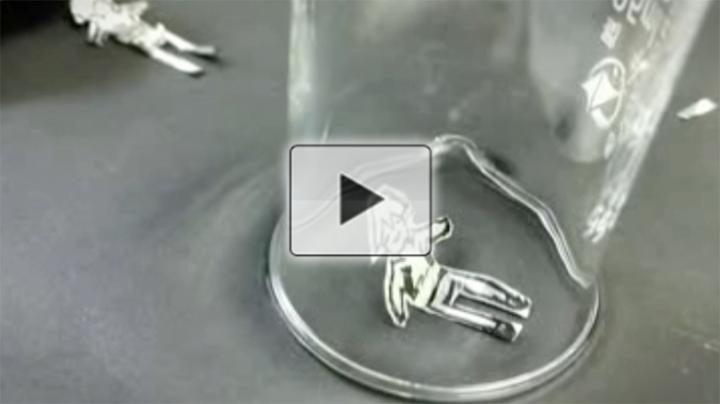
Credit: American Chemical Society
Scary movies about dolls that can move, like Anabelle and Chucky, are popular at theaters this summer. Meanwhile, a much less menacing animated doll has chemists talking. Researchers have given a foil “paper doll” the ability to move and do sit-ups with a new material called polymer covalent organic frameworks (polyCOFs). They report their results in ACS Central Science. Watch a video of the material in action here.
Scientists make conventional COFs by linking simple organic building blocks, such as carbon-containing molecules with boric acid or aldehyde groups, with covalent bonds. The ordered, porous structures show great potential for various applications, including catalysis, gas storage and drug delivery. However, COFs typically exist as nano- or micro-sized crystalline powders that are brittle and can’t be made into larger sheets or membranes that would be useful for many practical applications. Yao Chen, Shengqian Ma, Zhenjie Zhang and colleagues wondered if they could improve COFs’ mechanical properties by using linear polymers as building blocks.
The researchers based their polyCOF on an existing COF structure, but during the compound’s synthesis, they added polyethylene glycol (PEG) to the reactants. The PEG chains bridged the pore space of the COF, making a more compact, cohesive and stable structure. In contrast to the original COF, the polyCOF could be incorporated into flexible membranes that were repeatedly bent, twisted or stretched without damage. To demonstrate how polyCOFs could be used as an artificial muscle, the team made a doll containing the membrane as the waist and aluminum foil as its other parts. Upon exposure to ethanol vapors, the doll sat up; when the vapors were withdrawn, it laid down. The researchers repeated these actions several times, making the doll do “sit-ups.” The expansion of polyCOF pores upon binding the gas likely explains the doll’s calisthenics, the researchers say.
###
The authors acknowledge funding from the National Natural Science Foundation of China, Tianjin Natural Science Foundation of China and the National Science Foundation.
The study is freely available as an ACS AuthorChoice article here.
For more research news, journalists and public information officers are encouraged to apply for complimentary press registration for the ACS fall 2019 national meeting in San Diego.
The American Chemical Society, the world’s largest scientific society, is a not-for-profit organization chartered by the U.S. Congress. ACS is a global leader in providing access to chemistry-related information and research through its multiple databases, peer-reviewed journals and scientific conferences. ACS does not conduct research, but publishes and publicizes peer-reviewed scientific studies. Its main offices are in Washington, D.C., and Columbus, Ohio.
To automatically receive news releases from the American Chemical Society, contact [email protected].
Follow us on Twitter | Facebook
Media Contact
Katie Cottingham
[email protected]
Related Journal Article
http://dx.




